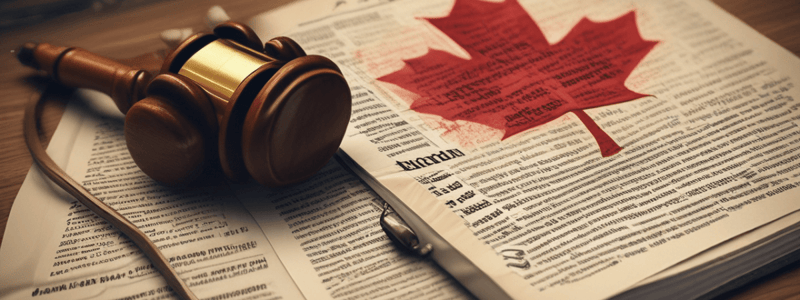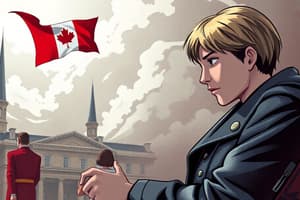Podcast
Questions and Answers
What is the classification of the offense for hindering a person making the 'proclamation'?
What is the classification of the offense for hindering a person making the 'proclamation'?
- Hybrid - imprisonment not more than 2 years
- Hybrid - imprisonment not more than 10 years
- Indictable - liable to imprisonment for life (correct)
- Summary conviction offense
Where must a riot occur according to the Criminal Code?
Where must a riot occur according to the Criminal Code?
- Anywhere (correct)
- In public places only
- In a designated riot zone
- Under specific government buildings
What is the maximum penalty for wearing a mask or disguise to conceal identity while taking part in a riot?
What is the maximum penalty for wearing a mask or disguise to conceal identity while taking part in a riot?
- Hybrid - imprisonment not more than 2 years
- Indictable - imprisonment not more than 10 years (correct)
- Hybrid - imprisonment not more than 5 years
- Summary conviction offense
What is the classification for the offense of 'taking part in a riot'?
What is the classification for the offense of 'taking part in a riot'?
Who is authorized to read the riot proclamation?
Who is authorized to read the riot proclamation?
What is the classification for the offense of 'being a member of an unlawful assembly'?
What is the classification for the offense of 'being a member of an unlawful assembly'?
According to Section 25(4) of the Criminal Code of Canada, a peace officer is justified in using force intended to cause death or grievous bodily harm if the officer believes on reasonable grounds that it is necessary for:
According to Section 25(4) of the Criminal Code of Canada, a peace officer is justified in using force intended to cause death or grievous bodily harm if the officer believes on reasonable grounds that it is necessary for:
According to Section 34 of the Criminal Code of Canada, a person is justified in using force to prevent the commission of an offense if the offense would likely cause:
According to Section 34 of the Criminal Code of Canada, a person is justified in using force to prevent the commission of an offense if the offense would likely cause:
According to Section 27 of the Criminal Code of Canada, a person is justified in using reasonable force to prevent the commission of an offense if:
According to Section 27 of the Criminal Code of Canada, a person is justified in using reasonable force to prevent the commission of an offense if:
Which section of the Criminal Code of Canada addresses the use of force on board an aircraft?
Which section of the Criminal Code of Canada addresses the use of force on board an aircraft?
According to the Criminal Code of Canada, the use of force on board an aircraft is permitted under which circumstances?
According to the Criminal Code of Canada, the use of force on board an aircraft is permitted under which circumstances?
According to Section 34 of the Criminal Code of Canada, the force used to prevent the commission of an offense must be:
According to Section 34 of the Criminal Code of Canada, the force used to prevent the commission of an offense must be:
What is the primary purpose of Soft Physical Control?
What is the primary purpose of Soft Physical Control?
Which of the following is considered a Hard Physical Control method?
Which of the following is considered a Hard Physical Control method?
What characterizes Intermediate Weapons?
What characterizes Intermediate Weapons?
Which of the following falls under the category of Lethal Force?
Which of the following falls under the category of Lethal Force?
In the context of physical control, what is the main purpose of Lethal Force?
In the context of physical control, what is the main purpose of Lethal Force?
According to section 7(8), when is an aircraft considered to be 'in flight'?
According to section 7(8), when is an aircraft considered to be 'in flight'?
Under section 27.1(1), what must a person on an aircraft believe on reasonable grounds for the use of force to be justified?
Under section 27.1(1), what must a person on an aircraft believe on reasonable grounds for the use of force to be justified?
To which aircraft does section 27.1 apply?
To which aircraft does section 27.1 apply?
What type of force is justified under section 27.1(1)?
What type of force is justified under section 27.1(1)?
In the case of a forced landing where the operator loses control, when does the aircraft stop being considered 'in flight' under section 7(8)?
In the case of a forced landing where the operator loses control, when does the aircraft stop being considered 'in flight' under section 7(8)?
If a person uses force on an aircraft to prevent a suspected offense, but their belief was not reasonable, would they still be legally justified under section 27.1(1)?
If a person uses force on an aircraft to prevent a suspected offense, but their belief was not reasonable, would they still be legally justified under section 27.1(1)?
Which section of the Criminal Code makes it a crime for a police officer to neglect or intentionally ignore a riot that is taking place within his/her jurisdiction?
Which section of the Criminal Code makes it a crime for a police officer to neglect or intentionally ignore a riot that is taking place within his/her jurisdiction?
The riot proclamation must be read in its entirety and verbatim for the police to act against rioters or any other person who has assembled at that place in an unlawful manner.
The riot proclamation must be read in its entirety and verbatim for the police to act against rioters or any other person who has assembled at that place in an unlawful manner.
Where in the Criminal Code will you find the riot proclamation?
Where in the Criminal Code will you find the riot proclamation?
What federal law provides Canada with the legal authority to hand over persons located in Canada, to another country if the person is wanted for an offense in the other country?
What federal law provides Canada with the legal authority to hand over persons located in Canada, to another country if the person is wanted for an offense in the other country?
A police officer shall not draw a handgun, point a firearm, or discharge a firearm unless...
A police officer shall not draw a handgun, point a firearm, or discharge a firearm unless...
Ontario's police officers are not permitted to use force on a person or carry a firearm unless they have successfully completed a training course on either of those subjects during the previous ___.
Ontario's police officers are not permitted to use force on a person or carry a firearm unless they have successfully completed a training course on either of those subjects during the previous ___.
What is the federal statute that deals with national security concerns, as well as threats of espionage by foreign powers and terrorist groups?
What is the federal statute that deals with national security concerns, as well as threats of espionage by foreign powers and terrorist groups?
For a police officer to use force, they must have an ___ belief that ___ grounds actually exist to use force.
For a police officer to use force, they must have an ___ belief that ___ grounds actually exist to use force.
Which portion of the "Two Limb Test" asks whether a reasonable person would have believed that reasonable grounds existed (to use force) if they'd been in the same situation as the police officer?
Which portion of the "Two Limb Test" asks whether a reasonable person would have believed that reasonable grounds existed (to use force) if they'd been in the same situation as the police officer?
What does Section 146 of the Provincial Offences Act authorize police officers to do?
What does Section 146 of the Provincial Offences Act authorize police officers to do?
True or False: For a police officer to use force, they must have an honest belief that reasonable grounds actually exist to use force.
True or False: For a police officer to use force, they must have an honest belief that reasonable grounds actually exist to use force.
According to Section 27.1(1) of the Criminal Code, a person on an aircraft is justified in using force to prevent the commission of an offense if they ___ on reasonable grounds that the offense would likely endanger the safety of the aircraft or of any person on board the aircraft.
According to Section 27.1(1) of the Criminal Code, a person on an aircraft is justified in using force to prevent the commission of an offense if they ___ on reasonable grounds that the offense would likely endanger the safety of the aircraft or of any person on board the aircraft.
What distinguishes Soft Physical Control from Hard Physical Control?
What distinguishes Soft Physical Control from Hard Physical Control?
Which technique falls under the category of Intermediate Weapons?
Which technique falls under the category of Intermediate Weapons?
What characterizes a control technique associated with Lethal Force?
What characterizes a control technique associated with Lethal Force?
Which weapon is typically categorized as Hard Physical Control?
Which weapon is typically categorized as Hard Physical Control?
In the context of physical control options, which method is least likely to result in serious injury?
In the context of physical control options, which method is least likely to result in serious injury?
Where can one find the provision in the Criminal Code regarding the offense of a police officer neglecting or intentionally ignoring a riot within their jurisdiction?
Where can one find the provision in the Criminal Code regarding the offense of a police officer neglecting or intentionally ignoring a riot within their jurisdiction?
Which federal law grants Canada the authority to extradite individuals wanted for offenses in other countries?
Which federal law grants Canada the authority to extradite individuals wanted for offenses in other countries?
In what situation are Ontario's police officers permitted to use force or carry a firearm without recent training on those subjects?
In what situation are Ontario's police officers permitted to use force or carry a firearm without recent training on those subjects?
Under what circumstances may a police officer draw, point, or discharge a firearm according to regulations found in COPSA?
Under what circumstances may a police officer draw, point, or discharge a firearm according to regulations found in COPSA?
What is the primary requirement for a police officer to act against rioters or unlawful assemblies after reading the riot proclamation?
What is the primary requirement for a police officer to act against rioters or unlawful assemblies after reading the riot proclamation?
What section of the Criminal Code deals with the offense of hindering an individual making the riot proclamation?
What section of the Criminal Code deals with the offense of hindering an individual making the riot proclamation?
What is the main purpose of using a 'Relational Approach' to policing?
What is the main purpose of using a 'Relational Approach' to policing?
Which of the following is considered a form of 'Active Resistance'?
Which of the following is considered a form of 'Active Resistance'?
What is the primary consideration when determining if a use of force response is 'Risk Effective'?
What is the primary consideration when determining if a use of force response is 'Risk Effective'?
Which of the following is an example of 'Intermediate Weapons'?
Which of the following is an example of 'Intermediate Weapons'?
What is the main purpose of using 'Hard Physical Control' techniques?
What is the main purpose of using 'Hard Physical Control' techniques?
In what circumstance would the use of 'Lethal Force' be justified?
In what circumstance would the use of 'Lethal Force' be justified?
What is the purpose of the Ontario Public-Police Interactions Training Aid?
What is the purpose of the Ontario Public-Police Interactions Training Aid?
What is the main purpose of the guiding principles outlined in the text?
What is the main purpose of the guiding principles outlined in the text?
What is the history of the Use of Force models/Training Aid in Canada?
What is the history of the Use of Force models/Training Aid in Canada?
What is the key difference between the Use of Force models/Training Aid and the Criminal Code of Canada in terms of justifying the use of force by police?
What is the key difference between the Use of Force models/Training Aid and the Criminal Code of Canada in terms of justifying the use of force by police?
What is the purpose of the 'Relational Approach' mentioned in the guiding principles?
What is the purpose of the 'Relational Approach' mentioned in the guiding principles?
What is the main purpose of the 'De-escalation' techniques mentioned in the guiding principles?
What is the main purpose of the 'De-escalation' techniques mentioned in the guiding principles?




